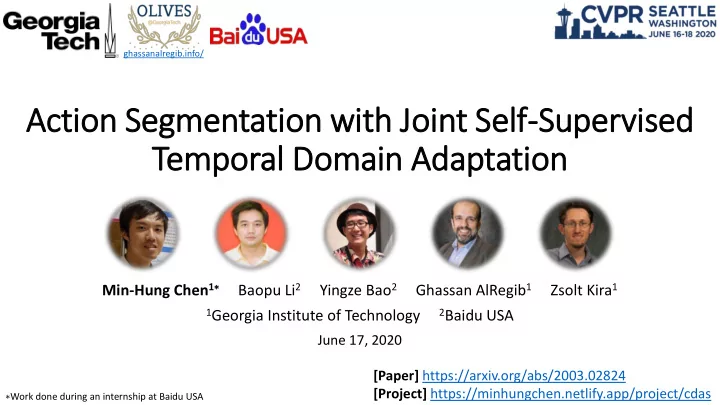

ghassanalregib.info/ Action Segmentation with Jo Join int Self-Superv rvised Temporal Domain Adaptation Min-Hung Chen 1 ∗ Baopu Li 2 Yingze Bao 2 Ghassan AlRegib 1 Zsolt Kira 1 1 Georgia Institute of Technology 2 Baidu USA June 17, 2020 [Paper] https://arxiv.org/abs/2003.02824 [Project] https://minhungchen.netlify.app/project/cdas ∗ Work done during an internship at Baidu USA
Action Segmentation Action segmentation = Action Recognition + Temporal Segmentation Input Video Begin End Make milk Time Segmentation Model End Begin Output Predictions Time take cup spoon powder background pour milk 2
Action Segmentation Source Videos Unlabeled Labels Videos Standard Action Segmentation Fully Focus on architecture design Supervised Learning with fully-supervised learning Source Model 3
Challenge Source Videos Target Videos Unlabeled Unlabeled Labels Videos Videos Standard Action Segmentation Fully Source model may not Focus on architecture design Supervised work on target videos Learning with fully-supervised learning Source vs. Target Source Source Model Model Different people perform the same action in different styles 4
Adapting Source Model Source Videos Target Videos Unlabeled Unlabeled Labels Labels Videos Videos Goal Fully Adapt the source model Supervised without additional labels Annotating data is Learning time consuming! Source Target Model Model Model Adaptation 5
Goal Source Videos Target Videos Adapt the source model with unlabeled data Unlabeled Unlabeled Labels Labels Videos Videos Fully Supervised Learning Source Target Previous Works Model Model Adversarial-based Self-Supervised Domain Adaptation Model Adaptation Learning Not consider Not consider dependencies between cross-domain adapted features discrepancy 6
Temporal Domain Permutation Source Target Previous Works • Predict temporal orders Segment & • Predict binary domains Shuffle Intuition DA for classification ➔ domain classification DA for segmentation ➔ domain segmentation Domain Permutation Prediction Our Method Predict temporal permutations of domains [0,0,1,1] [0,1,1,0] [1,1,0,0] ℒ 𝑒 [0,1,0,1] [1,0,1,0] [1,0,0,1] 7
Self-Superv rvised Temporal Domain Adaptation (S (SSTDA) Target Original videos Source Segment & Shuffle Domain-shuffled Frame-level or video-level feature feature Local SSTDA Global SSTDA Binary Sequential Domain Domain Prediction Prediction Training ℒ 𝑚𝑒 ℒ 𝑚𝑒 ℒ 𝑒 ℒ 𝑒 Adversarial training ADC: Adversarial Domain Confusion [1] with ℒ 𝑧 , ℒ 𝑚𝑒 , ℒ 𝑒 ℒ 𝑚𝑒 : local domain loss ℒ 𝑒 : global domain loss ADC ADC 8 [1] JMLR 16
Our Approach: SSTDA Source Videos Target Videos Unlabeled Unlabeled Labels Labels Videos Videos Video Variations Fully Supervised Learning Source Target Self-Supervised Temporal Domain Adaptation Model Model (SSTDA) Video-based Domain Adaptation with self-supervised learning to reduce variations in videos Action Predictions 9
Experimental Results Ground Truth Prediction 50Salads [1] Source-only: results from directly running the official released code of MS-TCN [2] 50Salads 50Salads F1@10 F1@10 F1@25 F1@25 F1@50 F1@50 Edit score Edit score 75.4 73.4 65.2 68.9 Source-only [2] Local SSTDA 79.2 77.8 70.3 72.0 83.0 81.5 73.8 75.8 SSTDA SSTDA (65%) 77.7 75.0 66.2 69.3 Effectively exploit unlabeled target videos for action segmentation 10 [1] UbiComp 13 , [2] CVPR 19
Comparison: Unlabeled Target Vid ideos 50Salads F1@10 F1@25 F1@50 Edit score Source-only 75.4 73.4 65.2 68.9 VCOP [1] 75.8 73.8 65.9 68.4 DANN [2] 79.2 77.8 70.3 72.0 JAN [3] 80.9 79.4 72.4 73.5 MADA [4] 79.6 77.4 70.0 72.4 MSTN [5] 79.3 77.6 71.5 72.1 MCD [6] 78.2 75.5 67.1 70.8 SWD [7] 78.2 76.2 67.4 71.6 83.0 81.5 73.8 75.8 SSTDA Jointly adapt domains with multiple temporal scales can better address discrepancy problems for videos 11 [1] CVPR 19, [2] JMLR 16, [3] ICML 17, [4] AAAI 18, [5] ICML 18, [6] CVPR 2018, [7] CVPR 19
Vis isualization: 50Salads Ground Truth Expectation Only highlight the difference from the ground truth MS-TCN [1] Local SSTDA SSTDA action start peel cucumber cut cucumber place cucumber into bowl cut tomato cut lettuce place lettuce into bowl cut cheese place cheese into bowl place tomato into bowl mix ingredients add oil add vinegar mix dressing add pepper 12 serve salad onto plate add dressing action end [1] CVPR 19
Summary • Goal: adapt action segmentation models using unlabeled videos • Approach: Self-Supervised Temporal Domain Adaptation (SSTDA) • Perform domain adaptation for multiple temporal scales • Learn feature representations with domain-invariant temporal dynamics • Outperform other self-supervised methods and image-based DA methods • Improve action segmentation by large margins using unlabeled target videos Paper Project Code Poster: #93 @ Session 2.4 Date: June 17 (Wed.) Q&A Time: 16 - 18 & 04 - 06 [Paper] https://arxiv.org/abs/2003.02824 [Project] https://minhungchen.netlify.app/project/cdas [Code] https://github.com/cmhungsteve/SSTDA 13
Recommend
More recommend